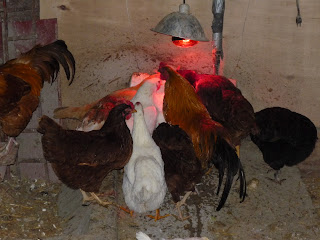I have a part-time job where I work at an environmental center. One of the classes we teach is called Outdoor Living Skills. We use something we call “the Rule of 3’s” to teach kids how to prioritize their survival needs in an emergency. Everyone needs food, water, air and shelter in order to survive.
Let’s put those in order of importance:
You can survive 3 minutes without air. (Better get out of the water!)
You can survive 3 hours without shelter. (Weather dependent)
You can survive 3 days without water.
You can survive 3 weeks without food.
So assuming your lost and also assuming you’re not submerged in water, you’d better start looking for some shelter ASAP. Once you can protect yourself from the elements, then you worry about water.
Should you worry about food? Well, maybe. But most likely you’ll be found long before you’d starve to death.
So what does this have to do with farming?
Well, when you’re a livestock farmer, you’ve gotta be prepared. The animals depend on us to provide them with food, water and shelter. I don’t know if the Rule of 3’s is exactly the same for animals–the time ratios likely change. But it does help me prioritize what needs to be done first.
Shelter in the winter is of utmost importance. Animals have no electric blankets, no heated barns, no tea kettles on the burner. We must provide them with a place to hide from the wind and snow, and a nice straw bed in which they can hunker down and keep warm.
But water is a close second. The animals rely on their metabolism to keep themselves warm. They ramp it up in the cold weather, and it won’t “fire up” without lots of fresh water.
So when I walked into the chicken barn the other day, I immediately knew something was wrong.
First off, the chickens ran towards me, not away.
Hmmn. The chickens and I have a pretty cool relationship. They don’t fear me, yet I’m not their favorite person either. When things are running smoothly, they could take me or leave me.
But not today. Today these birdies were all over me.
In fact, they were fighting over the snow on my boots.
Next I saw this:

That’s the heat lamp that keeps their water thawed out in the winter. You see, we have automatic waterers for the chickens. And we worked very hard developing our system. (I use the term we very loosely here.)
We have a heat lamp on the spigot where the pipe comes up from the well. We tied insulation around the pipe to keep it nice and warm. We connected a garden hose to this pipe, around which we have wound electric tape, around which we have added another layer of foam insulation.
(You might do well to substitute
he for
we in that whole paragraph, if you know what I’m saying.)

The insulated hose runs through a window into the interior of the barn here…..

…and to a water trough equipped with a float:
It works pretty similar to your toilet. When the water levels drop, the float opens a valve to let more water in.
We farmers are an ingenious lot. Cough.
You did notice the cat in the picture, right?
In Irish Grove, we believe in inter-specie-al harmony.

Anyways, someone put a chink in our system by knocking the light bulb out of the lamp. And the float froze to the trough.
Our chickens were so thirsty, that one of them had stuck her head out a little hole in the barn door to eat snow…..and got stuck. I didn’t get a picture of her because I was so distressed.
Her head and one wing were outside in the elements, and the rest of her body was inside, smushed under the barn door. Poor birdy. If I hadn’t checked on the chickens that morning, she would’ve died for sure. I gently slid open the barn door, trying not to break her wing, and set her free. She was OK. Whew!
I knew the birds were thirsty because they all ran outside into the snow and started to eat it.

Chickens normally don’t like snow.
Then I spent the next 3 hours running back and forth from the house to the barn. I was boiling water on the stove to pour into the water trough. I was trying to melt the ice-jammed float.
Finally the ice melted, the water started flowing, and the birds got a drink of fresh water.

Disaster averted. Barely.
When you’re a livestock farmer, you can never relax. If you do, you threaten the very lives of your animals. That’s why I developed the Farmer’s Rule of 3’s:
Check your animals, 3 times a day.
